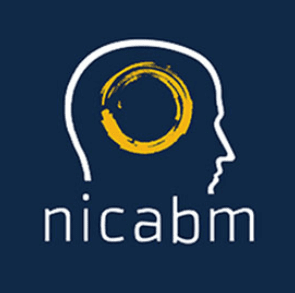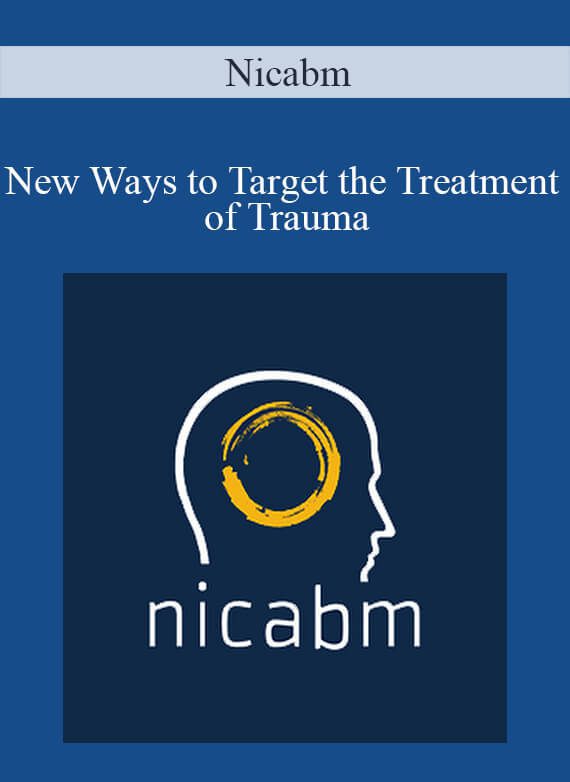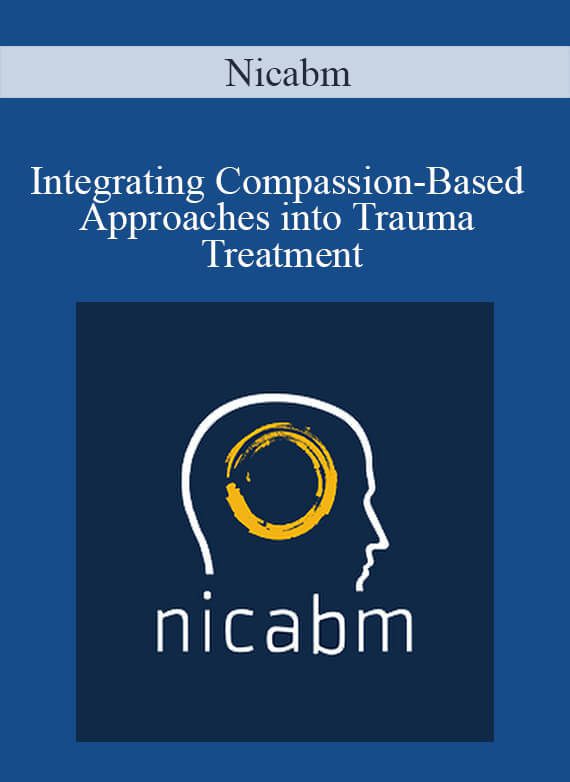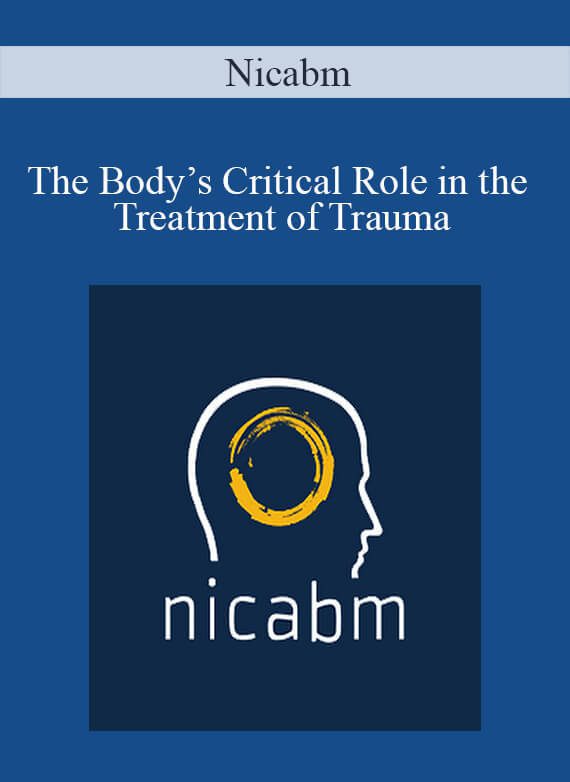[Download Now] NICABM – Work with a Client’s Resistance
$197.00 Original price was: $197.00.$40.00Current price is: $40.00.
Digital Download: You will receive a download link via your order email
Should you have any question, do not hesitate to contact us: [email protected]
[Download Now] NICABM – Work with a Client’s Resistance
PLEASE REFER TO OUR PROOF : WATCH HERE!
NICABM – Work with a Client’s Resistance
Expert Strategies for Dissolving Your Client’s Resistance
When our clients are distrustful or skeptical of our work, it can create difficult barriers to healing.
To us, this can sometimes feel like resistance.
But is resistance even a valid notion?
What may at first seem like opposition, can often signal our client’s deepest struggles.
The difficult part is seeing beyond the “push back” to take in the important message our client is telling us, so we can work with instead of against their energy.
So we asked the top 20 experts in our field how they worked with their most challenging clients. We were surprised by the deep dive of their answers.
They gave us useful skills that can radically shift this kind of resistance and actually help reverse a client’s ambivalence to change.
That’s why we made. . .
How to Work with a Client’s Resistance

How to Help Clients Shift Out of Avoidance so They Can Heal
Part 1: How to Work with Reluctance Linked to Attachment Issues
Pat Ogden, PhD Kelly McGonigal, PhD
- How a client’s movement vocabulary can reveal an inner conflict
- One way to help clients reestablish a sense of identity in their body
- How to approach implicit memories that fuel a client’s avoidance

Part 2: How to Resolve the Core Threat That’s Fostering Your Client’s Opposition
Sue Johnson, EdD Kelly McGonigal, PhD
- How to change a combative session into a collaborative one
- How to isolate the main threat that’s feeding a client’s rigidity
- The simple but powerful way validation impacts an avoidant mindset

One Hidden Fear That May Be Driving Your Client’s Reluctance
Laurel Parnell, PhD Rick Hanson, PhD
- The counterintuitive reason your client may be avoiding change
- The unique way guilt affects a client’s feelings of unwillingness

How to Help Clients Move Out of a Defensive State
Bessel van der Kolk, MD Stephen Porges, PhD Ron Siegel, PsyD
- The critical reason some clients fear calmness
- One physiological change that can alter how we interact with others
- The specific breathing pattern that can trap a client in a defensive state

3 Skills to Expand a Client’s Openness to Change
Kelly McGonigal, PhD Bill O’Hanlon, LMFT Ron Siegel, PsyD
- One personality type that is most prone to challenging the therapy
- A 3-step action plan to foster change without triggering opposition
- How to promote a healthier mindset that resists barriers to growth

How to Work with the Deep Vulnerabilities That Keep a Client from Change
Richard Schwartz, PhD Kelly McGonigal, PhD Bill O’Hanlon, LMFT
Terry Real, MSW, LICSW Ron Siegel, PsyD
- The crucial message that can soften a client’s protective parts
- The specific way to introduce hope in the healing process (so it’s actually received)
- How to work with “rational deformity” to help clients build authentic connections
- The silent vulnerability that’s most often behind a client’s reluctance

How to Avoid Misdiagnosing Clients as Unmotivated
Michael Yapko, PhD Bill O’Hanlon, LMFT Ron Siegel, PsyD
- The key factor that falsely presents as a lack of motivation
- The vital message your client is giving you when they don’t follow your advice
- The important difference between resistance and rigidity
- How a client’s specific cognitive style can keep them stuck in avoidance

How to Sell Behavior Change to Your Most Challenging Clients
Marsha Linehan, PhD Peter Levine, PhD
- What can go wrong when you engage a client’s willfulness
- How to help clients be more open to your interventions
- What a client needs to get from you before they’ll agree to your ideas

How to Help Clients Shift from Reluctance to Openness
Shelly Harrell, PhD Ron Siegel, PsyD Kelly McGonigal, PhD
- How to identify seeds of unwillingness inside the therapeutic alliance
- One change that can improve your outcome with clients who oppose all your ideas
- How to work with clients who struggle to disclose feelings
- 3 therapeutic messages to help clients reverse their reluctance

How the Practitioner May Be Perpetuating Opposition in Their Client
Rick Hanson, PhD Bill O’Hanlon, LMFT Zindel Segal, PhD
Ron Siegel, PsyD Kelly McGonigal, PhD Joan Borysenko, PhD
- What can go wrong when you resist a client’s resistance
- How to recognize the dangerous way a client’s willfulness may be affecting you
- How to foster a high level of support for clients who don’t do the work
Register Here for Only $197
and get 12 videos, audios, transcripts, plus 5 bonuses
to help you work more effectively with a client’s depression
Sign Me Up
4 CE/CME Credits or Clock Hours are available for purchase at checkout.
Click HERE to get information about CE/CME credits and clock hours as well as speaker disclosures
“You will grow as a human being . . . it’s that powerful”
— Terri Boling, Licensed Counselor —


Stephen Porges, PhD
Developer of Polyvagal Theory; Distinguished University Scientist at the Kinsey Institute at Indiana University Bloomington and Research Professor in the Department of Psychiatry at University of North Carolina Chapel Hill

Marsha Linehan, PhD
Creator of Dialectical Behavior Therapy (DBT); Professor of Psychology, Adjunct Professor of Psychiatry and Behavioral Sciences at the University of Washington and Director of the Behavioral Research and Therapy Clinics

Peter Levine, PhD
Founder of Somatic Experiencing; Author of Trauma and Memory: Brain and Body in a Search for the Living Past: A Practical Guide for Understanding and Working with Traumatic Memory

Pat Ogden, PhD
Pioneer in Somatic Psychology; Founder and Director of Sensorimotor Psychotherapy Institute (SPI); Co-founder of the Hakomi Institute; Author of Sensorimotor Psychotherapy: Interventions for Trauma and Attachment
Richard Schwartz, PhD
Founder of Internal Family Systems (IFS) and The Center for Self Leadership
Neuroscientist and Professor of Psychiatry at Boston University Medical School. Author of The Body Keeps the Score: Brain, Mind, and Body in the Healing of TraumaSue Johnson, EdD
Creator of Emotionally Focused Therapy (EFT); Founder and Director of the International Centre for Excellence in Emotionally Focused Therapy
Licensed Psychologist specializing in multicultural and community psychology; A Professor with the Pepperdine Graduate School of Education and Psychology
Executive Director of the Mindsight Institute; Co-Director of UCLA’s Mindful Awareness Research Center; author of Mindsight: The New Science of Personal Transformation and The Mindful Therapist: A Clinician’s Guide to Mindsight and Neural Integration
Senior Fellow of the Greater Good Science Center at UC Berkeley; New York Times bestselling author of Hardwiring Happiness and Buddha’s Brain
Creator of Acceptance and Commitment Therapy (ACT); Nevada Foundation Professor at the Department of Psychology at the University of Nevada, Reno
Assistant Clinical Professor of Psychology, part time, Harvard Medical School; Author of The Mindfulness Solution: Everyday Practices for Everyday Problems and Sitting Together: Essential Skills for Mindfulness-Based Psychotherapy
A founder of Mindfulness-Based Cognitive Therapy (MBCT); Professor of Psychology at the University of Toronto
Leading expert in Eye-Movement Desensitization and Reprocessing (EMDR); Author of Attachment-Focused EMDR: Healing Relational Trauma
Health psychologist and lecturer at Stanford University; Author of The Upside of Stress: Why Stress Is Good for You and How to Get Good At It and The Willpower Instinct: How Self-Control Works, Why It Matters, and What You Can Do to Get More of It
Founder of Mind/Body Health Sciences LLC; Author of New York Times Bestseller Minding the Body, Mending the Mind
Co-developer of Solution-Oriented Therapy; Psychotherapist, speaker, and author of Do One Thing Different: Ten Simple Ways to Change Your Life
Founder of the PACT Training Institute and developer of a Psychobiological Approach to Couple Therapy (PACT)
Leading expert in clinical hypnosis and treating depression; Clinical psychologist and author of 15 books including his newest books, The Discriminating Therapist and Keys to Unlocking Depression
Founder of the Relational Life Institute; author of I Don’t Want to Talk About It: Overcoming the Secret Legacy of Male Depression and The New Rules of Marriage: What You Need to Make Love Work

Course Director
Ruth Buczynski, PhD
Here’s What You’ll Get:
Everything is yours to keep forever in your professional library
| Downloadable videos so you can watch at your convenience, on any device | |
| Audio recordings you can download and listen to at home, in the car, at the gym or wherever you like | |
| Professionally-formatted transcripts of the sessions, to make review and action simple | |
| Five downloadable bonus videos to help you work more effectively with a client’s resistance |
Get 5 Bonuses That Give You Even More Strategies for Working with a Client’s resistance

The Brain Science Behind a Client’s Unwillingness (and How It Can Foster More Powerful Interventions)
Dan Siegel, MD Kelly McGonigal, PhD
Joan Borysenko, PhD
- How “spiritual bypass” can keep clients stuck in avoidance (and how to work with it)
- Why underdevelopment of this part of the brain can lead to reluctance

How to Work with Avoidant Relationships
Stan Tatkin, PsyD, MFT
- Why it’s vital for you to introduce pain and discomfort in your work with certain couples
- How to help couples confront the vital issues they’ve learned to avoid

The Key Message Inside Your Client’s Unwillingness
Steven Hayes, PhD Bill O’Hanlon, LMFT
Kelly McGonigal, PhD Ron Siegel, PsyD
- Why you should always walk toward your client’s resistance
- One professional risk that can strengthen the therapeutic relationship and foster change

One Change That Can Unravel a Client’s Rigid Beliefs
Kelly McGonigal, PhD Ron Siegel, PsyD
Bill O’Hanlon, LMFT
- The clarifying reason we need pushback from our clients
- Why you need to feel uncomfortable in your session (this can make all the difference)
- What lies beneath most clients’ rigid beliefs

How to Engage with a Willful Client
Marsha Linehan, PhD Ron Siegel, PsyD
Kelly McGonigal, PhD
- The parenting model that can improve your work with willful clients
- The trick to working with willfulness (it may go against your natural inclination)
- The danger of using contingency management to foster behavior change
Register Here for Only $197
and get 12 videos, audios, transcripts, plus 5 bonuses
to help you work more effectively with a client’s depression
Sign Me Up
4 CE/CME Credits or Clock Hours are available for purchase at checkout.
Click HERE to get information about CE/CME credits and clock hours as well as speaker disclosures
Starting Today, This Program Can Change the Way You Practice

– After your purchase, you’ll see a View your orders link which goes to the Downloads page. Here, you can download all the files associated with your order.
– Downloads are available once your payment is confirmed, we’ll also send you a download notification email separate from any transaction notification emails you receive from IMC.sale.
– Since it is a digital copy, our suggestion is to download and save it to your hard drive. In case the link is broken for any reason, please contact us and we will resend the new download link.
– If you cannot find the download link, please don’t worry about that. We will update and notify you as soon as possible at 8:00 AM – 8:00 PM (UTC+8).
Thank You For Shopping With Us!
Be the first to review “[Download Now] NICABM – Work with a Client’s Resistance” Cancel reply
Related Products
Medical & Health
[Download Now] Nicabm – Integrating Compassion-Based Approaches into Trauma Treatment
Medical & Health
[Download Now] Nicabm – New Ways to Target the Treatment of Trauma
Medical & Health
Medical & Health
Nicabm – The Body’s Critical Role in the Treatment of Trauma
Login
![[Download Now] NICABM - Work with a Client’s Resistance](https://imc.sale/wp-content/uploads/2022/02/NICABM-Work-with-a-Clients-Resistance-100x100.jpg)

![[Download Now] Darek Woś - Caliathletics](https://imc.sale/wp-content/uploads/2022/02/Darek-Wos-Caliathletics-100x100.jpg)
![[Download Now] Talmadge Harper - Gorgeous Pill Awaken Your Physical Beauty](https://imc.sale/wp-content/uploads/2022/02/Talmadge-Harper-Gorgeous-Pill-Awaken-Your-Physical-Beauty-100x100.jpg)
![[Download Now] NICABM - Work with a Client’s Resistance](https://imc.sale/wp-content/uploads/2022/02/NICABM-Work-with-a-Clients-Resistance.jpg)


![[Download Now] Nicabm - The Advanced Master Program on the Treatment of Trauma](https://imc.sale/wp-content/uploads/2022/02/Nicabm-The-Advanced-Master-Program-on-the-Treatment-of-Trauma.jpg)
![[Download Now] Nicabm - The Body's Critical Role in the Treatment of Trauma](https://imc.sale/wp-content/uploads/2022/02/Nicabm-The-Bodys-Critical-Role-in-the-Treatment-of-Trauma.jpg)
![[Download Now] Nicabm - Integrating Compassion-Based Approaches into Trauma Treatment](https://imc.sale/wp-content/uploads/2022/02/Nicabm-Integrating-Compassion-Based-Approaches-into-Trauma-Treatment.jpg)
![[Download Now] Nicabm - New Ways to Target the Treatment of Trauma](https://imc.sale/wp-content/uploads/2022/02/Nicabm-New-Ways-to-Target-the-Treatment-of-Trauma-1.jpg)
![[Download Now] Nicabm - Expert Strategies for Working with Impostor Syndrome](https://imc.sale/wp-content/uploads/2022/02/Nicabm-Expert-Strategies-for-Working-with-Impostor-Syndrome.jpg)



10 reviews for [Download Now] NICABM – Work with a Client’s Resistance
There are no reviews yet.